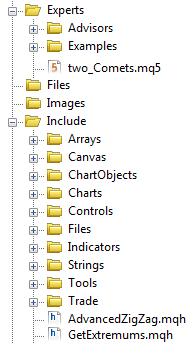*.mqh - in Librares? It would be good to give explanations in the articles, for dummies.....
Pilin...... of 3 files compiled only 1 of them without errors, the other two files give several dozens of errors, please describe the correct sequence for installing......
Explain to me, please, what it means here is drawn, when I read the article a little differently imagined, and now I understand only that the red is a zigzag....
*.mqh - in Librares? It would be good to give explanations in articles, for dummies.....
Files should be copied as follows:

Hilarious on the M5
And it can trade, I ticked it - it turned green.....
This is an indicator, but it is made in the form of an Expert Advisor. It will trade if you add the necessary functionality to it.
The files should be copied as follows:
- Free trading apps
- Over 8,000 signals for copying
- Economic news for exploring financial markets
You agree to website policy and terms of use


New article The ZigZag Indicator: Fresh Approach and New Solutions is published:
The article examines the possibility of creating an advanced ZigZag indicator. The idea of identifying nodes is based on the use of the Envelopes indicator. We assume that we can find a certain combination of input parameters for a series of Envelopes, whereby all ZigZag nodes lie within the confines of the Envelopes bands. Consequently, we can try to predict the coordinates of the new node.
Every trader surely knows the ZigZag indicator intended for the analysis of price movements of given or greater amplitude. A ZigZag line is a broken line whose nodes are located at highs and lows of the price chart.
There are many variations of this indicator. Yet, a lot of MQL5 program developers are keen on creating their own 'ideal' ZigZag.
We will set an objective: to find coordinates of two nodes - the current and the predicted node (Fig. 1). The current node is a node that is not yet completed whose coordinates are still being searched for or adjusted. Moreover, it is always on the current (zero) bar. While being in the future, a predicted node must show the estimated level of the next ZigZag node.
Fig. 1. Predicting new ZigZag nodes: the current node and the next node.
Author: Sergey Pavlov